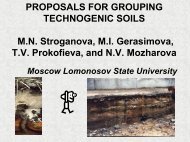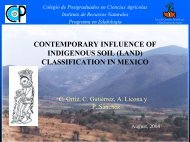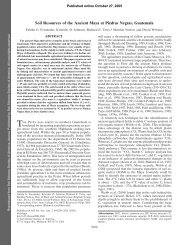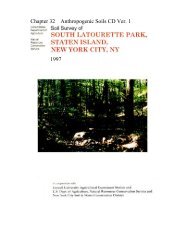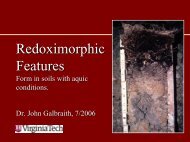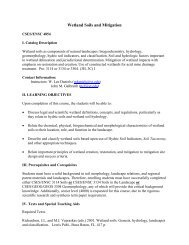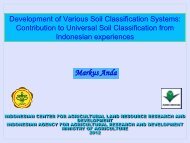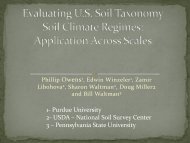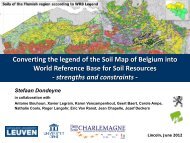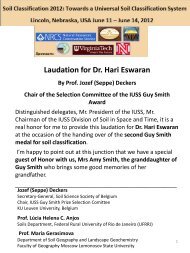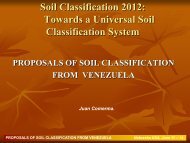Nebraska Soils Field Trip - Virginia Tech
Nebraska Soils Field Trip - Virginia Tech
Nebraska Soils Field Trip - Virginia Tech
You also want an ePaper? Increase the reach of your titles
YUMPU automatically turns print PDFs into web optimized ePapers that Google loves.
4th IUSS Soil Classification Conference <strong>Field</strong> Tour Guidebook<br />
Figure WS3 presents the general loess thickness in the Midcontinent. The thickest loess occurs<br />
in western Iowa and south central NE. Two loess sources account for this distribution. One<br />
source is the Missouri Valley (Ruhe et al., 1967; Simonson and Hutton, 1954; Muhs and Bettis,<br />
2000), which served as glacial outlet beginning, at least during Illinoisan time (Mason, 2006.).<br />
Aleinikoff et al. (1998, 1999), using geochemical analysis showed that Peoria Loess across<br />
<strong>Nebraska</strong> came from non-glacial sources of the western Great Plains (White River and Arikeree<br />
siltstones). Mason (2001) reached similar conclusions using Peoria Loess thickness trends.<br />
Landscape Evolution<br />
Despite widespread occurrence of glacial and loess deposits, the field area is an erosional<br />
landscape that displays dissection and a well-integrated drainage. The terrain resembles<br />
erosional landscapes developed solely on relatively flat-lying sedimentary rocks. As the<br />
landscape declines in elevation from higher primary divides to lower secondary divides, younger<br />
stratigraphic units are truncated by erosion and older units are exhumed and exposed at the<br />
land surface (Hallberg, 1980). Ruhe1967, following extensive field study, developed a soil<br />
landscape and geomorphic model for southwest IA. This model is appropriate to the field area.<br />
Fig WS4 depicts this model.<br />
Four geomorphic surfaces descend from stream divides to major drainages. The uppermost<br />
surface is blanketed by loess that overlies a paleosol developed on till or a clay-rich material<br />
known as gumbotil (Kay, 1916), which is interpreted as weathering product from till. . The clayrich<br />
material may alternatively represent an early loess deposit (Woida and Thompson, 1993).<br />
Ruhe (1967) named the paleosol for time period it represented, the Yarmouth Sangamon (YS)<br />
paleosol (Yarmouth is the classical North American interglacial between Kansan and Illinoisan<br />
glaciations).<br />
Episodic erosion cut a pediment below the YS surface and the associated materials. This<br />
geomorphic surface Ruhe (1967) named the late-Sangamon Pediment. In Ruhe’s study area<br />
(Greenfield quadrangle, Adair County) the Loveland Loess is absent, elsewhere this erosion<br />
cycle removes or truncates the Loveland Loess. Hence, the paleosol formation period spans<br />
only a portion of the Sangamon interglacial and Ruhe refers to it as the Late Sangamon. The<br />
paleosol under this surface is formed in transported material called pedisediment (Ruhe and<br />
Cady, 1954). A traceable stone line lies below the pedisediment, which in turn is underlain by<br />
pre-Illinoisan till.<br />
Episodic erosion produced a second pediment during early Wisconsin time. This erosion cycle<br />
removed the pre-existing soil. The modern soil on this surface has reformed in the truncated,<br />
less-weathered pre-Illinoisan till. Wisconsin age loess originally covered this surface, but<br />
subsequent hillslope erosion removed it at the site shown in Figure WS4.<br />
An erosional down cutting cycle accompanied by headward stream incision and hillslope<br />
backwearing began in late Wisconsin time. All loess deposition predates this surface, hence<br />
modern soils form into the truncated pre-Illinoisan till. This erosional surface descends to<br />
Holocene alluvial deposits. This surface Ruhe (1967) called the late-Wisconsin dissection<br />
slope.<br />
15



